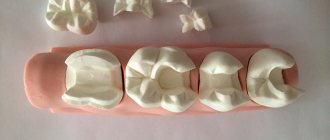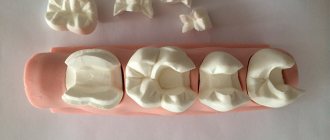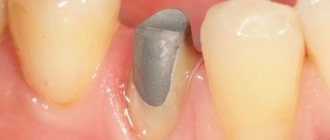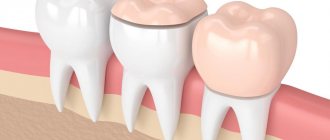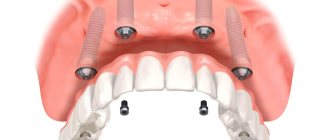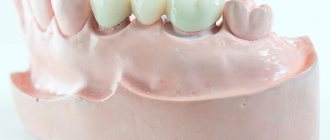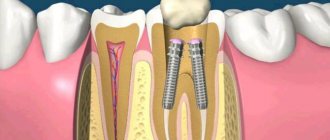In modern dentistry, there are many different methods for restoring damaged teeth - filling, prosthetics, installing inlays. The first two technologies are well known to patients, but few people know that teeth can be successfully restored with inlays.
What are tooth inlays, how do they differ from regular fillings, and in what cases is the use of inlays indicated? We will answer all these questions in detail in this article on our website.
What is it - a tooth tab?
Dental inlays are microprostheses that can be used for different purposes. Restorative or restorative inlays are used like fillings: they help recreate the natural crown of a tooth, keeping it alive. Stump inlays are used in cases where it is necessary to restore a badly damaged tooth under a crown. Let's take a quick look at why restoration and stump inlays are used, and find out the difference between them.
Restoring inlays are stronger than conventional dental fillings and differ from them in the technology of their creation: dental inlays are not made directly in the patient’s mouth, like fillings, but in a dental laboratory, using previously taken impressions. Because microdentures are made in a laboratory setting, they are also called indirect dental inlays.
The inlays exactly repeat the shape of the cavity that needs to be closed for tooth restoration and fit tightly to the natural tissues. The high density of adhesion of the inlay to the tooth tissue eliminates the risk of developing caries in the gap between the installed microprosthesis and the tooth. Restoring a tooth with an inlay will help keep the tooth alive in a situation where a sufficient amount of tooth tissue has been preserved, its nerve is alive and well, but a large filling still needs to be placed. Large fillings do not stick well to the teeth and can break under stress, along with the tooth. Inlays have a long useful life, can withstand chewing loads well, and their use makes it possible not to rush into dental prosthetics with a crown, which often requires preliminary depulpation of teeth.
Stump inlays for a tooth are no longer a restoration element, but a technical one. It acts as a support for the installation of a dental crown in cases where the tooth cannot be restored qualitatively with a conventional filling. In order not to confuse stump and restoration inlays, the easiest way to classify them is as follows: restorative inlays are installed outside the living tooth, stump inlays are always located under the crown.
This is the main classification of inlays, but they can also differ in the type of material they are made of, and below we will definitely talk about all the types of microprostheses and their features. But first, let's find out who and when is recommended to install inlays on teeth.
Implant-fixed crown
When implanting in one stage or with a protocol with instant loading, implants are used that consist of a single integral structure - one-piece. They can be intended for implantation into the cancellous or basal layer of bone tissue; types of implants are compression and basal. The crown is fixed with cement.
Implants are installed if there are indications:
- The tooth is subject to urgent or planned extraction;
- The root of the tooth is broken and requires removal;
- Contraindications to other types of prosthetics;
- The tooth has mobility.
Basal implants are installed when a tooth has already been removed, usually more than 6 months, there is a lack of bone tissue volume, inflammation that prevents classical implantation, and a smoking habit.
Contraindications:
- Inflammation of the gums;
- Chronic diseases that prevent surgical operations (oncology, heart disease, respiratory tract disease, immune system disease, etc.)
- Exacerbation of diseases that are relative contraindications;
- Deep carious lesions;
- Cyst, granuloma;
- Severe destruction of bone tissue;
- Violation of the process of bone tissue regeneration;
- Blood clotting disorders.
In the first six months after installation, the crown on the implant is made of lightweight materials so as not to disrupt the process of osseointegration. As a rule, it is plastic, it is cheap, has a good appearance, however, it quickly accumulates plaque and is not resistant to scratches. It is changed after the implant has stabilized - after 4-7 months. The most common materials for permanent crowns are metal-ceramics, ceramics and zirconium.
Indications for dental restoration with inlays
Let's look at all the cases in which the use of tabs may be indicated. It is recommended to use tabs:
- If the tooth is destroyed by more than 1/3;
- With increased wear of chewing teeth;
- When restoring teeth that in the future will have to act as a support for a crown or installation of a bridge;
- For large carious cavities in the teeth, the elimination of which with conventional fillings is ineffective.
The need to use inlays is determined by the dentist during the examination of the patient. Based on the clinical situation, the specialist will choose the type of microprosthesis that is suitable for you, both in terms of functionality and material of manufacture.
Indications and contraindications
The main indications for restoring the aesthetics of elements using structures:
- increased abrasion of enamel;
- severe mechanical damage to the crown of the tooth;
- destruction of the crown by more than 30%;
- the need to use the unit as a support for the prosthesis;
- using ceramic inlays instead of fillings.
The products are an improved version of fillings that are made to order. Installation of structures is not possible in all cases.
Contraindications for the procedure are:
- the need to restore milk elements;
- destruction of the crown by more than 60-70% (in this case, doctors offer crowns to patients);
- lack of a healthy root system of the tooth;
- serious mechanical damage to the unit, in which nothing remains of it;
- destruction of incisors or canines (inlays, as a rule, are not used for the restoration of these elements);
- progression of carious processes in the oral cavity.
Photos before and after installing a ceramic inlay
Experts also do not recommend restoring wisdom teeth using ceramic structures. Eights do not play any role in the process of chewing food and are invisible to others, so there is no point in spending money on their expensive restoration.
Types of restoration dental inlays: description, characteristics
In this section of the article, we will tell you about what restoration dental inlays can be, used in tooth restoration as an alternative to conventional fillings. Prostheses will be classified mainly according to the material of manufacture and according to this criterion, the inlays can be ceramic, composite, or metal. The material of the tooth inlay will affect both the performance characteristics of microprostheses and their cost.
Ceramic tooth inlay and its features
Most often, ceramic dental inlays are used to restore chips on living teeth and act as a high-quality and more reliable alternative to conventional fillings.
Ceramic inlays can only be placed on teeth that are alive, not loose, and have been treated for caries. Ceramic dental inlays have many advantages: they are aesthetically pleasing, durable, do not change their beautiful color even with prolonged use, and do not wear off. The high density of the marginal contact of the ceramic inlay with the natural tissues of the tooth eliminates the risk of developing secondary caries.
But ceramic dental inlays have some disadvantages. Some consider the disadvantages of ceramic inlays for teeth to be the high price of this type of microprosthesis in Moscow (from 8 thousand rubles), however, it should be noted that the high cost is fully justified by the long service life of ceramic inlays and their impeccable aesthetics. Please note that with ceramic inlays installed on your teeth, you will need to give up the habit of chewing nuts, crackers, and other types of too hard foods with your teeth. The ceramic inlay may not withstand such heavy loads!
Metal tooth tab: characteristics, pros, cons
Metal restoration inlays are used quite rarely these days, and all because microprostheses made from this material have a number of disadvantages:
- When installing metal inlays in the mouth, a very unpleasant galvanic side effect for the patient may occur, expressed in constant and profuse salivation, a pronounced metallic taste in the mouth;
- Installing metal inlays does not allow for high-quality and tight contact between the microprosthesis and the natural tissues of the tooth, and this increases the risk of developing secondary caries. Gold inlays on teeth can provide a good fit, but their price will be high, because gold is a noble and expensive metal;
- Metal inserts can cause allergic reactions;
- The aesthetics of metal inlays also leaves much to be desired.
The only significant advantage of metal inlays for teeth is the fairly low price for this type of microprosthesis in Moscow. The cost of a metal tab in the capital’s clinics starts at 4,000 rubles for one orthopedic product.
Composite inlays for teeth
Composite inlays are used to restore single-rooted teeth, which include incisors and canines, that is, the front teeth included in the smile area.
Installation of a composite inlay can only be carried out if the tissue in the tooth being restored is preserved in a volume of at least 50%. Composite inlays are also called pin inlays because when they are placed in the tooth canal, a pin is first placed on which the dentist will apply the composite material in layers. If the tooth is severely damaged, installing an inlay on a pin is not recommended, since over time the pin may begin to wobble in the tooth canal and its mobility can lead to a fracture of the tooth root. If your tooth is more than half destroyed, you do not need a restoration, but a stump inlay followed by installation of a crown!
How much will a composite tooth inlay cost? The answer to this question will depend on what type of post and composite material the dentist uses during the restoration process.
The price of a restoration insert will also depend on the method of its manufacture. All inlays, except composite ones, are created in the laboratory using dental impressions. The tooth for the inlay must be ground down, although the volume of tissue removed will be less than the amount of dental tissue that is removed for the crown. The most complex manufacturing technology is for ceramic crowns, which are made from pressed ceramics: they are created using CAD/CAM computer technology. The complexity of the technology increases the price of ceramic inlays, but such microprostheses will have high anatomical accuracy, which means they will last longer.
Kinds
There are 3 main types of inlays, which differ in material of manufacture, service life and cost. The modern type of material from which products are made is metal ceramics. Their cost is not much different from ceramic structures, but in quality they are significantly inferior to them. Cermet inlays may fall out when exposed to too high or low temperatures. This is due to the ability of the metal to expand under the influence of temperature factors. For this reason, dentists do not advise patients to resort to modern methods of dental reconstruction.
Inlays can also be made from pressed ceramics. Porcelain is used to produce structures of the required shape and size under the influence of high temperatures. As a result of laboratory work, inlays are durable and resistant to external influences. In terms of strength, they are not inferior to zirconium samples. Ceramic structures are recommended for use in cases of significant destruction of dental elements.
Zirconium is another material used to make inlays. The resulting products are in no way inferior to porcelain in terms of technical characteristics. They are turned on modern machines using pre-prepared plaster models. All stages of work are controlled automatically by high-precision devices.
It is allowed to use stump products to restore a completely destroyed coronal part, provided that the tooth root is preserved. After the procedure, a crown or bridge is attached to the tab
Depending on their purpose, structures are divided into restorative and stump. The former allow you to restore the integrity of the tooth crown with a healthy root system.
How are restoration inlays installed on teeth?
Installing a restorative inlay on teeth is a multi-step process that always begins with a detailed diagnosis, which will include examination, radiography and computed tomography. After the diagnosis, the type of inlay is selected and a detailed treatment plan is drawn up.
The tooth on which the inlay is planned to be placed is ground down and then an impression is taken from it and sent to a dental laboratory. An inlay will be made based on the impression and the average production time is 5-7 days.
When the inlay is ready, the patient is invited to the clinic for fitting and installation of a microprosthesis. The inlay is fixed in the tooth cavity using special dental cement.
Is it possible to put an inlay on the front teeth?
Inlays are not used for the restoration of anterior teeth. If there is a sufficient amount of healthy tooth tissue, the tooth is restored with a regular filling and then a veneer or lumineer can be placed on it to obtain a beautiful aesthetic restoration in the smile area. If the tooth is severely damaged, then it makes sense to install a stump tab and then a crown.
The traditional area of application for restoration inlays is chewing teeth.
Can a tooth get sick under an inlay and what to do if this happens?
If the tooth under the inlay hurts, you need to urgently contact a dental clinic, because pain under the installed microprosthesis can indicate the development of various kinds of complications. The main cause of complications after installing an inlay is medical errors that were made during the treatment process, and that is why it is so important to choose dentistry carefully! If, when treating a tooth, the doctor allows the pulp to overheat, an inflammatory process may begin, as a result of which the tooth under the tab will become sore. To eliminate pulpitis, you will have to remove the tooth inlay, receive appropriate treatment, and then restore the tooth again, possibly with a prosthetic crown or even implantation.
Inlays are often placed on teeth after caries treatment and it is extremely important that when working with a carious cavity, the dentist removes all destroyed tissue. If this is not done, secondary caries will begin under the tab, the treatment of which will again require removal of the tab.
Remember that if 5-7 days have passed after installing the inlay on the tooth, and your tooth hurts and the intensity of the pain is increasing, you need to urgently see a dentist, and not try to solve the problem yourself! If the infection gets into the root part of the tooth, it is not always possible to save the tooth and avoid its removal!
If the tooth does not hurt, but you have the feeling that it is bothering you - when eating, talking, trying to close your teeth - contact the clinic where you received the inlay to have its size corrected.
What materials are used?
The main criterion when choosing materials in prosthetics is strength. The higher the load on the teeth, the stronger the artificial elements should be. Traditionally, metals and alloys are used: gold, cobalt and chromium, nickel and chromium, palladium and silver. Ceramics and metal-ceramics, as well as composite materials, are widely used.
It is noteworthy that in European countries and the USA, metal inlays are chosen to restore molars as they are more reliable. The choice is explained simply: photopolymer and composite fillings can crumble and fall out. Since molars are not visible when you smile, the color and texture of the dentures are of little importance.
Stump inlays: what do you need to know about them?
At the very beginning of our article, we said that stump inlays should not be confused with restorative microprostheses - they are used to restore pulpless and severely damaged teeth, in which they will serve as the basis for installing a crown or dental bridge.
Stump inlays are structures consisting of two parts: a pin installed in the root canal and a support on which the crown will be fixed. Stump inlays can be monolithic or collapsible, and most often this type of structure is used when the tooth has less than 50% of healthy tissue left.
Many people are interested in the question: why is it best to use core inlays rather than fillings on a pin to restore severely damaged teeth? The fact is that the pin may not withstand the load and begin to wobble in the canal, and this will either lead to the filling breaking or falling out, or, worst of all, to damage to the tooth root, in which the tooth is most often removed. Stump inlays allow you to avoid such risks because they distribute the load more correctly and themselves have much greater strength compared to pins.
Stump inlays are also made in the laboratory and the construction material is selected to match the type of dental crown that is planned to be placed in the future. Metal core inlays are used for metal-ceramic crowns, and zirconium inlays are used for ceramic crowns. If you make a metal inlay for a ceramic crown, it can shine through the thin and transparent material of the crown, which will have a bad effect on the aesthetics of the restoration.
Tooth restoration using a core inlay will also be divided into several stages: diagnostics, preparation, during which a cavity is formed in the tooth for the inlay, manufacturing of the inlay, and its installation. After installing the core tab, the crown is fixed on it and this completes the process of tooth restoration.
If the tooth is destroyed, but there is a living nerve in it, before installing the stump tab, depulpation is carried out, as well as treatment and filling of the root canals. It is important that these procedures are carried out without errors, since poor canal processing leads to various kinds of complications, the elimination of which requires complex and lengthy treatment.
Installation technique
Reconstruction of row elements using ceramic inlays occurs in stages:
- First, old fillings (if any) are removed. Teeth preparation occurs using a cooling system that prevents overheating of bone tissue. Grinding of the restored unit often occurs with the use of magnifying dental instruments (binocular glasses). Thanks to them, the doctor will be able to preserve a larger volume of healthy dentin tissue.
- After preparation, the resulting cavity is processed with a caries detector. The method allows you to identify the affected areas remaining after preparation.
- Precision grinding and smoothing of tooth edges with Arkansas stone. The steps of the procedure are necessary to ensure a good fit of the ceramic inlay.
- After this, an impression is taken from the problem unit, from which the dental technician will create an inlay. Checking the compliance of the parameters of the inlay with the resulting cavity is also carried out using binocular glasses.
At the last stage, the manufactured product is attached to the tooth. Various adhesives are used for this purpose. After installation of the structures, the patient will need to adhere to a number of rules in order to extend the life of the inlays.
Private clinics practice a new method of dental restoration using the Chairside technique, which allows you to restore the aesthetics of your smile in one visit to the dentist.
During the procedure, the dentist uses a device equipped with a three-dimensional camera. Powder is applied to the work area before taking the photo. This makes the image more accurate and clear. The 3D device transmits the resulting image to a large screen and uses it to calculate the parameters of the future tab. All data is transmitted to the grinding unit, which grinds the product. The procedure takes no more than 30 minutes.
Tab lifespan
The service life of restoration inlays will depend on the material and production technology of microprostheses, as well as on how accurately the patient follows the dentist’s recommendations. Composite inlays last about 5-7 years, ceramic inlays - up to 20 years. This is subject to high-quality dental and oral hygiene and regular visits to the clinic for preventive examinations.
Stump inlays can last you a lifetime, and crowns on them last up to 15-20 years.
Do you still have questions about restorative and core dental inlays? Ask them to the orthopedists of our dentistry in Moscow - Vanstom! You can make an appointment with the clinic’s doctors at any time convenient for you - through the chat on our website, the call back form, or simply by dialing the contact phone number!
Which crown is better: rating
Below we will talk about the best options for prosthetics of chewing teeth in different clinical situations. In Table 1 you can see which crown is better in situations where only single crowns are needed, or when we are talking about restoring a missing tooth with a bridge. The types of crowns in the table are listed from best to worst.
Dental crowns: which ones are best for chewing teeth (Table 1) –
| Single crown | Bridge prosthesis | |
| 1. | pressed ceramic E.max | made of zirconium dioxide |
| 2. | made of zirconium dioxide | combined bridge * |
| 3. | metal ceramics | metal ceramics |
| 4. | solid crown | solid bridge |
* This prosthetic option involves a combination of metal-ceramic and solid-cast bridge prosthesis. So, if from the table it has already become clear to you which crown is best to place on chewing teeth, then below you will find a detailed description of the pros and cons of the above types of crowns in various clinical situations.
1) Crowns/bridges made of zirconium dioxide –
Zirconium dioxide is a metal-free ceramic. This type of ceramic has very high strength (more than 900 MPa), which is comparable to the strength of metal, as well as a higher level of aesthetics - compared to metal ceramics. If you need to make a bridge on the chewing group of teeth, then a zirconium dioxide bridge will be the best option. But if you need to make a single crown, then zirconium is inferior to pressed glass ceramics E.max.
Pressed glass ceramics E.max has: 1) better aesthetics, 2) it has a lower risk of chipping the ceramic mass, but it cannot be used to make bridge-like prostheses resting on the distal chewing teeth. Therefore, if at least one of 6-7-8 teeth must act as supports for a bridge, the only ceramic option will be zirconium dioxide. If you need a single crown, read the next section about E.max ceramics.
Important: Most often, zirconium dioxide crowns/bridges consist of two layers. First, the zirconium frame of the future crown/bridge is milled on a computer-controlled machine (similar to the metal frame of metal-ceramics). After firing in the kiln, layers of porcelain in different shades are applied to this frame to match the color of the adjacent teeth.
The second manufacturing option is that crowns/bridges are made from monolithic zirconium dioxide (without subsequent application of porcelain layers). This option has a big advantage - there is absolutely no risk of ceramic chipping, but the aesthetics will be worse. According to statistics, when making zirconium crowns with surface application of porcelain, ceramic chips occur in approximately 10% of patients after 6 years of using such crowns.
At the same time, studies show that the risk of ceramic chips in metal-ceramic crowns is approximately 2 times lower (than in zirconium crowns with a surface layer of porcelain). And the risk of chipping with pressed E.max glass ceramics will be even lower. Therefore, to the question: which crowns are best placed on chewing teeth, the answer is that bridges are best made from monolithic zirconium dioxide, and single crowns from E.max.
→ Cost of zirconium dioxide crowns/bridges
2) Crowns made of pressed ceramics E.max –
Two single crowns from E.max – before and after photos
E.max glass ceramics are the best option for metal-free ceramics if you have the highest demands on the aesthetics of your crowns. This type of ceramic has a high strength of 400 MPa (which is less than that of zirconium dioxide), but this is more than enough for prosthetics of posterior teeth with single crowns. But for the manufacture of bridges supported by 6-7-8 chewing teeth, this strength will no longer be enough, and therefore bridges from E.max are made more often for the front teeth.
E.max comes in two main types. Firstly, this is the “E.max PRESS” material, intended for the manufacture of crowns/bridges using the pressing method at high temperature and pressure. Let's say right away that this material is much better and somewhat cheaper than the second one. Secondly, the “E.max CAD” material, which is intended for the manufacture of crowns using the milling method (CAD/CAM technology, which is also used for the manufacture of zirconium crowns).
Important: E.max crowns/bridges can be (as well as zirconium) made either monolithic or consist of 2 layers - a pressed frame on which porcelain mass will be applied. Monolithic structures have the lowest risk of ceramic chipping, while layered structures have the best aesthetics. Not long ago, a new material “E.max PRESS Multi” appeared, which makes it possible to make very aesthetic monolithic structures, from which we recommend making all single crowns for chewing teeth.
→ Cost of crowns/bridges from E.max
3) Metal-ceramic crowns/bridges –
A more budget-friendly option is metal-ceramic prosthetics. Its main aesthetic disadvantages are more modest aesthetics (compared to metal-free ceramics), the development of cyanosis of the gums around the crown, and also, over time, gum recession with exposure of the metal edge of the crown. But on the other hand, chewing teeth are not visible when you smile, which, given a limited budget, makes metal-ceramics a good choice.
Below we have posted examples of prosthetics for missing chewing teeth using metal-ceramic bridges (before and after photos).
But aesthetics should not be the only selection criterion. The fact is that for metal-ceramics, teeth are ground on different sides by 2.0-2.5 mm, and for metal-free ceramics - only 1-1.5 mm. Thus, ceramic prosthetics allows you to preserve more hard tooth tissue under the crown, which increases its service life. The cost of one metal-ceramic crown starts from 8,000 rubles (for the most budget-friendly manufacturing option, using the cheapest materials made in Russia and Belarus).
On average, for a budget option using imported economy-class materials (for example, Duceram ceramic mass, Germany) - it costs from 10,000 to 12,000 rubles for 1 crown. If the issue of aesthetics is important to you, then the production of metal-ceramics using high-quality and expensive ceramic masses Vita (Germany), Noritake (Japan), Ivoclar (Liechtenstein) will cost at least 15,000 rubles for 1 crown. It is also worth considering that the indicated price does not take into account some additional costs.
→ Calculation of the cost of metal ceramics
4) Solid crowns/bridges –
Crown bridges on the back teeth (which do not fall into the smile line) do not have to be white and beautiful. There are metal cast crowns that are made of chromium-cobalt alloy. Such crowns have the color of polished metal, or by spraying they can be given a “gold” color. They have a long service life, and besides, the teeth under them are ground to a lesser extent than under metal-ceramics.
→ Calculation of the cost of cast crowns
5) Combined bridges –
If you need to make a bridge of 3 crowns on the chewing teeth (for example, supported by the 5th and 7th teeth), the design can be made in an unconventional way... The first 1-2 crowns that fall into the smile line can be made metal-ceramic, and the distant ones 1-2 crowns can be made solid and look like polished metal. This will be somewhat cheaper, and besides, it turns out that the abutment tooth for a cast crown will be ground down to a lesser extent.
